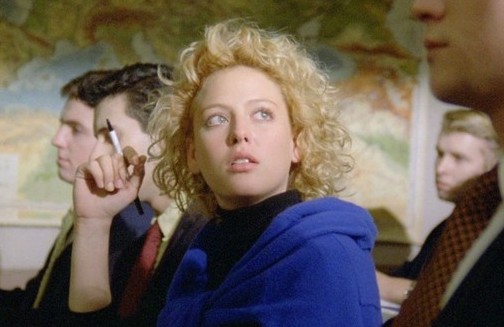
Tombs of the Blind Dead – 1972, Spain, 85m/100m (uncut). Director: Amando de Ossorio
The Return of the Evil Dead – 1973, Spain, 90m. Director: Amando de Ossorio
The Ghost Galleon – 1974, Spain, 87m. Director: Amando de Ossorio
Night of the Seagulls – 1975, Spain, 89m. Director: Amando de Ossorio

TOMBS OF THE BLIND DEAD (1972) Satanic knights from the Dark Ages rise from their dusty graves to feast on the blood of scantily clad women and ride on horseback in slow motion. The knights awaken without the use of sight (their eyes were devoured by crows pre-burial), but despite being nothing more than walking skeletons in robes, they can sense their prey through sound. A backpacker makes camp near the knight’s gravesite and is descended upon by the zombified pack in a suspenseful sequence. The screenplay is smart enough to understand the living characters are not nearly as interesting as the dead ones, and quickly revives recent victims of the blind dead as bloodthirsty ghouls. The film offers exposition of the knight’s historical dealings in witchcraft and human sacrifices in the form of a decrepit librarian whose scumbag son (José Thelman) is given some much deserved, limb-tearing justice by the zombies after he rapes a lesbian. In the annals of zombiedom, Tombs of the Blind Dead won’t be remembered as much of its Night of the Living Dead counterparts, but as an atmospheric chiller it comes recommended. B (Currently available on Plex, Shudder, AMC+, and YouTube.)

RETURN OF THE EVIL DEAD (1973) Despite its generic title, this is actually the second in the Blind Dead series from Spain, which began a year earlier with Tombs of the Blind Dead by introducing the dreaded Knights Templar—fifth century Satan-worshippers who rise from their graves to drink the blood of those who disturb their slumber. In this instance, it’s the quincentenary of the Knights’ massacre at the hands of villagers—villagers who burnt the Templars at the stake after gouging their eyes out with red hot pokers. The gimmick of these films—the zombies must find their prey through sound—is meant to provide a certain amount of suspense, but it’s difficult to get excited over one-dimensional characters who spend the majority of the movie screaming, moaning, and making as much noise as possible in order for the Knights to find them. That said, there’s an undeniable creepiness to the zombies, and the plot this time around seems to have been inspired even more by Night of the Living Dead than its predecessor. So, if you enjoyed the first movie, you’ll most likely enjoy this one. B– (Currently not streaming.)

THE GHOST GALLEON (1974) (AKA: Horror of the Zombies) Brainless bikini models and their male cohorts learn the seaweed-strewn decks of a decaying Spanish galleon is the wrong place for a publicity stunt when zombies crawl out of the woodwork. It might sound like yet another European venture into George Romero territory, but Ghost Galleon is the continuing saga of the “blind dead”—witchcraft-practicing medieval knights who were persecuted and killed in the fifth century. As previously seen in Tombs of the Blind Dead (1972) and Return of the Evil Dead (1973), the knights keep coming back as bloodthirsty zombies to lay waste to nearby villages, and to ride horseback in slow motion. There are no horses in this entry, but the ship gives the movie a much needed change of pace and helps the paper thin plot by offering heavy atmosphere and some actual chills. The galleon is basically a replacement for the “old dark house,” but the sets are impressive, given the obviously low budget. The knights themselves are sinister and unique enough to separate them from the pack of walking stiffs that flooded theaters throughout the seventies. The gore isn’t as high this time around, but the decapitation of one of the most annoying characters in the movie is definitely a highlight. B– (Currently streaming on Freevee.)

THE NIGHT OF THE SEAGULLS (1975) Those pesky Knights Templar are back in this final installment in the Blind Dead series. A doctor (Victor Petit) and his wife (Maria Kosti) move to a remote fishing village to take over the practice of a retiring physician, unaware the place is the stalking grounds of the zombified Templars, who ascend from their graves at night. To keep the Knights under control, the local hags make nightly sacrifices in the form of their younger offspring. The village idiot tries to warn the newcomers of danger but is tossed off a cliff by the superstitious townsfolk. Petit’s pretty housemaid offers herself as the next sacrifice in order to keep peace with the zombies, which is cut short when Petit gets the urge to become a hero and rescues the damsel, severing the human/zombie trust. An elaborate flashback to the Templar’s human days—which includes the cutting out of woman’s heart at the altar of a demonic statue—begins the film with a terrific Hammeresque vibe. Unfortunately, an overall lack of suspense and a climax that repeats the ending of Return of the Evil Dead makes Night of the Seagulls the weakest in the series. But if you just gotta know how it ends for our desiccated friends, you could do a lot worse than this fittingly elegant finale. C+ (Currently streaming on ShoutTV.)





































